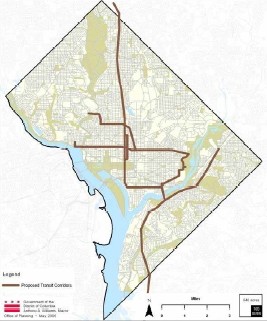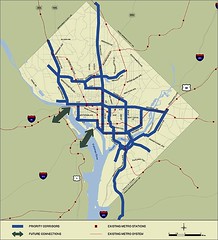Streetcar more than a nostalgic toy

DC Streetcar being tested in Europe. Image from the Center City Action Agenda April presentation, part 2.
This letter to the editor, by Ralph Garboushian, Transportation Committee chair, D.C. Chapter of the Sierra Club, appeared in yesterday's Examiner:
Re: “New Orleans’ trolley cars used to be main option,” July 18
We were pleased to see Steve Eldridge’s recent article about one of the most efficient, comfortable, urbane and civilized forms of transportation: the streetcar. However, we wish Eldridge had examined the streetcar systems of cities other than New Orleans — a devastated city that has lost half of its population, is struggling economically and has seen its streetcar network considerably scaled back.
Eldridge should travel to vibrant and bustling Toronto, which rather than abandon its streetcar system after World War II, modernized and expanded it at the same time it built a subway system.
Or Portland, Ore., which recently built a downtown streetcar line to complement its regional light rail system. Portland’s downtown is the envy of most U.S. cities and the streetcar is directly responsible for the redevelopment of a nearby warehouse district.
Or Melbourne, Australia, which like Toronto expanded and modernized its streetcar system and now boasts one of the world’s largest. Melbourne’s streetcars are beloved by its citizens, and Melbourne is regularly rated as Australia’s most beautiful and livable city. Indeed, cities with robust streetcars share the distinction of regularly landing at or near the top of lists of the world’s most livable cities.
The District’s proposal for a 40- to 50-mile streetcar network would be much more than a nostalgic toy for moving tourists. It would improve transit service along several key corridors that suffer from overcrowded and unreliable bus service, some of the longest transit travel times to employment centers in the city and have yet to benefit from the revitalization that Metrorail has brought to other District corridors.
Indeed, the primary goal of the proposed streetcar network is to improve mobility within the District. While our valuable Metrorail system does an excellent job of moving people around the region and especially from the suburbs to the District, it does not serve or connect many District neighborhoods.
Streetcars played an integral role in the District’s transportation history. From the turn of the century through WWII, streetcars were the primary mode of transportation for most Washingtonians and played a major role in the development of many D.C. neighborhoods. The abandonment of the District’s streetcar system in 1962 was a major mistake that accelerated the decline of many neighborhoods and contributed to the clogged streets and foul air we now grapple with daily.
Our current political leaders often talk about making Washington a world-class city and attracting 100,000 new residents. The District’s plan for a 40- to 50-mile streetcar network gives it the historic opportunity to correct the tragic mistake of their unelected 1962 counterparts and put Washington firmly on the path toward becoming a world-class city — and attracting 100,000 new residents without the nightmare of 100,000 new cars.

Proposed DC Streetcar Map as depicted in the Comprehensive Plan draft revision

Proposed streetcar lines according to the original DC Transit Future study.
Labels: accessibility, mobility, transit, transportation planning



0 Comments:
Post a Comment
<< Home